Alfalfa is nothing to fear with simple, proper management
Editor’s note: The following is part 2 of two-part series. See part 1.
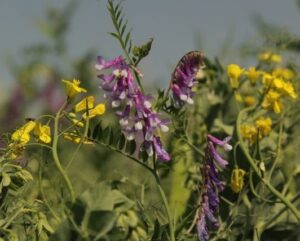
The secret — if it is a secret — to pasturing cattle on alfalfa is to follow a few simple management steps to reduce the risk of bloat, say producers from across the country, who for years claim good success by including the forage legume in pasture mixes.
Straight alfalfa stands can be managed quite well, but most producers today are favouring alfalfa/grass forage blends. They are very productive, produce excellent rates of gain on cattle, help to reduce the bloat risk, and also provide important biodiversity. Biodiversity benefits the cattle in providing a range of crops that mature at different times and can handle varying growing conditions, as well as biodiversity to benefit soil health.
The main “not to do” message is don’t turn somewhat hungry cattle into a pre-bloom high percentage stand of alfalfa and leave them to selectively graze the lush leaves. If there is a heavy dew or rain as well, it creates a perfect storm for bloat.
The key “to do” messages include making sure cattle move onto alfalfa pastures with a full gut and the forage stand is dry. Introduce them to lusher forage gradually by limiting the amount of area they have access to in a day, and force them to eat the whole plant including stems and not just leaves. Other “to do” strategies that some producers use — supply a bloat-control agent in cattle drinking water, make some dry hay available as well, as the fibre in hay reduces the risk of gas build up in the rumen, and include low-bloat forage legumes such as sainfoin in the pasture mix.
It is important to apply some basic management principles to capitalize on the benefits of having alfalfa in a grazing program. As grazing research summarized in Part 1 has confirmed over the years, not including alfalfa in pasture mixes can be like leaving money on the table.
Here is what producers from across the country had to say about how alfalfa is managed in their grazing programs:
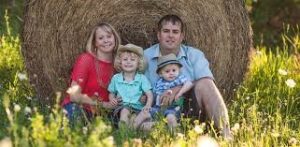
CHRIS KNIGHT
CLEAR CREEK FARMS
CHATHAM, ON
Including alfalfa and other legumes in a pasture mix, managed under a rotational grazing program, has been a significant factor in increasing carrying capacity on Chris Knight’s beef operation in southern Ontario.
Knight, farming with his brother Carl, produces purebred Black Angus cattle for their own direct marketing program on Clear Creek Farms near Chatham. He estimates during the past 10 to 15 years that carrying capacity of their pastures increased by about 40 percent using high quality forages in an intensive rotational grazing program.”Since we have been rotational grazing we are able to produce 40 per cent more beef on the same acres, same land base,” says Knight. “Including alfalfa in the pasture mix has made a huge difference.” He says the legume is a high-quality forage with excellent growth early in the grazing season, and under dryer mid and late summer growing conditions, the deep roots of the legume reach moisture and keep the plant growing well into fall.
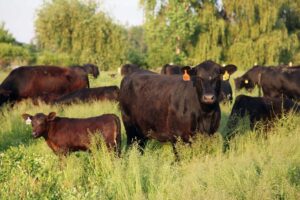
Knight has established mixed forages on pastures which are grazed from later May until early November. The blend includes between 50 to 60 per cent alfalfa along with some red and white clover as well as grasses such as orchard grass. While he knows there is an increased risk of bloat in grazing pastures high in legumes —particularly alfalfa —his management relies on timing.
“I don’t turn cattle onto pastures until the stand is maturing,” says Knight. “I wait to see the alfalfa starting to bloom and even the grasses are beginning to head out. A beef animal’s rumen can’t handle that high 20 to 22 per cent protein. By waiting, the quality may not be as high, but the forage still produces good rates of gain on the cattle.”
Depending on the year and stand maturity, Knight first turns cattle onto pasture around the May long weekend beginning a rest-rotation grazing program over the next five and a half months.
“For example, we put 50 cow-calf pairs in a paddock about one-half acre in size and early in the growing season generally plan to move every day,” he says. As the season progresses, and plant growth slows down, using portable electric fencing, he increases the size of the paddock, but still plans to move cattle daily. He moves cattle through a sequence of paddocks and doesn’t return to any one paddock until it’s had 45 to 50 days of regrowth.
“We’re usually able to make three passes through each paddock but again we make sure they’ve had that rest and plants are beginning to flower before we bring cattle back again,” he says.
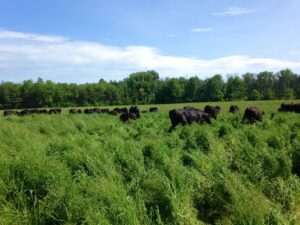
He uses a forage species blend for several reasons. He likes the plant diversity that includes different plants with different rooting structures, which help to improve soil health and soil quality. While the farm is tile drained, he says with deep-rooted crops such as alfalfa, during high moisture cycles, helps water infiltrates quickly into the soil.The 2018 growing season was a good example. His area was extremely dry up until late July. Alfalfa was able to reach subsurface moisture and keep growing while other forage species stopped growing. Then in late July it started raining “and never really stopped”. It was timely rain that saved many annual crops. Forage stands rebounded but his fields didn’t become saturated with standing water. That’s another reason he likes to keep both red and white clover in the forage mix. Red clover isn’t as well adapted to handle a lot of moisture, while white clover can.
The legumes also help fix nitrogen in the soil. Combined with manure from the intensive rotational grazing system, “I haven’t needed a bit of added fertilizer since I started the intensive grazing system,” says Knight.
And with a rest-rotation grazing system, the stands appear to have good longevity. “Since I started about 15 years ago I haven’t had to reseed anything,” he says. “They are still productive.” By grazing pastures a bit later, cattle are also eating legume and grass seeds, which pass through their systems and are deposited back on the pasture in manure. “With this system the pastures seem to be just renewing themselves,” he says.
Knight says the alfalfa/grass forage mix provides plant diversity which is good for the soil, and the deep-rooted alfalfa provides insurance forage supply if or when growing conditions are dry. And good quality forages keeps mature cattle in good condition and provides good rates of gain on calves that in late fall move into an on-farm finishing program.
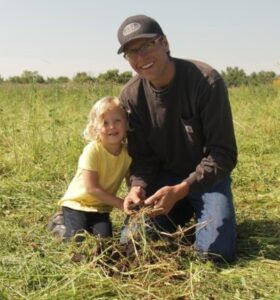
RYAN BOYD
SOUTH GLANTON FARMS
FORREST, MB
Ryan Boyd considers several things as he turns cattle into pastures that contain anywhere from 30 to 80 per cent alfalfa on his southern Manitoba farm, but two of the most important lessons he applies are: don’t turn cattle into alfalfa when they are hungry, and make sure the grass is dry, no rain or heavy dew.
Boyd says he has grazed cattle on mid to high percentage alfalfa pastures for several years. It involved a learning curve, but with proper management he says he can turn cow-calf pairs and long yearlings onto alfalfa and grass blend pastures with little concern about bloat.
“It all comes down to proper management,” says Boyd, who runs a mixed farming operation along with family members at Forrest, north of Brandon. Along with a 300 head Black Angus cow-calf beef herd that calves in June, he backgrounds all calves and sells them as long yearlings at about 14 months of age. And Boyd is not just learning about grazing cattle on his own farm. He has recently been awarded a Nuffield Scholarship and will be travelling extensively in many parts of the world over the next two years with a specific interest in learning more about grazing ruminants. Boyd knows from experience that cattle can bloat on high legume pastures. The first couple years he established alfalfa pastures some cattle did bloat. He began using a bloat control product added to livestock drinking water. That was effective, but he also learned he had to be sure the product was in fact in the water – the delivery system needs to be working properly.
As he investigated further to understand the growth characteristics of alfalfa and through careful field observations, he has developed a system where he is comfortable about grazing the legume. He knows, for example at the pre-bloom stage the crop is at a very high risk of causing bloat, but as it matures to the flowering and later stages the risk declines.
Now with primarily visual observation of crop maturity, Boyd says, “I am fairly confident now about turning cattle into pastures with alfalfa. The two most important things to remember is to make sure they aren’t hungry when you first turn them in, and also make sure the forage crop is dry. Don’t turn them in if there has been a heavy dew or on an overcast rainy day. On a dry day after lunch is probably the best timing.”
Boyd manages about 1,200 acres of mixed forage species pastures on the farm. He aims for a stand that is 30 to 40 per cent alfalfa, along with perennial grass species. The mix usually includes some annual crops such as oats or peas. A total mix of 10 to 12 pounds of seed will include two to three pounds of creeping or tap rooted alfalfa varieties. Grass species in the mixture can include meadow brome grass, orchard grass, and timothy, and/or other legumes such as sweet clover and cicer milkvetch.
“The two most important things to remember is to make sure they aren’t hungry when you first turn them in, and also make sure the forage crop is dry. Don’t turn them in if there has been a heavy dew or on an overcast rainy day. On a dry day after lunch is probably the best timing.”
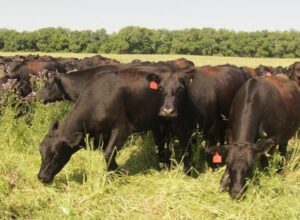
While his mixed legume/grass pastures have good longevity (many are 10 years old or more and still productive) there are usually one or two new pastures per year as some cropland is rotated out of annual cropland into forage production and vice versa. In the new seedings, Boyd pays close attention to the alfalfa component during the first two or three growing seasons. In the first year of establishment, new pastures may be grazed about 70 days after seeding with the annual crops such as oats or peas dominating. “The second and third years it’s almost a pure stand of alfalfa as the alfalfa comes on and the grass species take a bit longer to establish,” says Boyd. He doesn’t avoid grazing in second or third year by any means, but follows his management guidelines: Make sure cattle have a full gut before turning them into a new pasture, and make sure plants are dry – no dew or rain.
The South Glanton beef herd calves on pasture. Cows are coming off their winter feeding program – corn grazing, straw, and protein pellets and have been already grazing grass pastures and stockpiled forage as they move into the grazing rotation program in late spring.
Boyd targets a stocking density of a minimum 40,000 pounds of beef cattle per acre, although depending on the growth rate of forages that could range as high as 100,000 pounds of beef cattle per acre. Using portable electric fencing across the pasture, paddocks can range in size from one to five acres with cattle moved to a new paddock daily. Boyd gives pastures at least 60 days and sometimes up to 90 days to recover, and regrow before they are re-grazed. Usually the cow-calf pairs and backgrounded, stocker cattle move through separate rotations.
“If I follow my management guidelines, I have no trouble with bloat,” says Boyd. “I do watch the herd, but after three or four days their rumens seem to adjust to the alfalfa.”
Established pastures remain productive for 10 years or more with the alfalfa component holding steady. “On most of the older pastures there seems to be alfalfa everywhere,” he says.
While Boyd doesn’t like to lose any animal for any reason, he feels the benefits of keeping alfalfa in the pasture mix, far outweigh the risk of losses due to bloat.
Yearling steers consistently gain about two pounds per day, while cows carry through the grazing season in good condition, producing four to five month-old calves with weaning weights for 450 to 500 pounds at weaning in early November.
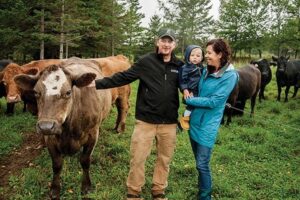
CEDRIC MACLEOD
LOCAL VALLEY BEEF
CENTREVILLE, NB
Cedric Macleod says a 50 per cent blend of alfalfa and grass species works well in the early stages of a seven-year pasture cycle on his beef farm in central New Brunswick.
MacLeod says, while alfalfa is productive, it generally doesn’t have longevity in his pasture stands. Most commonly high percentage or pure alfalfa stands are grown for stored feed — hay or silage crops for dairy operations.On his Local Valley Beef farm at Centreville, MacLeod establishes new pasture with 50 per cent of a branch rooted alfalfa variety along with grasses such as orchard grass, tall fescue, meadow fescue, and Italian ryegrass to make up the grass component.
As the alfalfa begins petering out during the first two to three years after seeding, he begins adding white clover to the pasture through a frost-seeding technique. In very early spring, clover seed is broadcast applied to pastures just as the frost is coming out the ground. The hoof action of cattle work seeds into the soil. That keeps clover in the pasture stand for another two to three years. In the fifth or sixth year he will use a paddock area for winter bale grazing before it is worked up and seeded the following season to corn for grazing. After corn grazing the pasture will be re-seeded to the alfalfa/grass blend to begin the cycle again.
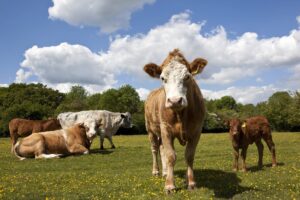
“Alfalfa is an excellent forage for putting condition on animals and improving rates of gain on feeder cattle,” says MacLeod. “But it doesn’t handle heavy grazing pressure and in this area we have low pH so unless soil fertility is properly balanced alfalfa doesn’t last very long.” He also says too much soil moisture can be hard on alfalfa as well. “I figure if I can get two, three or perhaps four years out of alfalfa I am doing well,” says MacLeod.
Also well aware of bloat concerns, MacLeod says grazing a 50/50 alfalfa/grass stand reduces the risk of bloat. “And one other trick I learned from long-time Alberta grazing mentor, Jim Stone, was always to make some grass hay available to cattle especially when first grazing alfalfa,” says Macleod.
“I’ve never had a problem with cattle bloating, but I always have a bale of good quality grass hay nearby the pasture, as well. Cattle are fairly intuitive and they’ll eat away at the green growth on pasture, but then they’ll also pick away at the hay too. It is like they know they need some roughage in their system too.”
Sharing or reprinting BCRC posts is welcome and encouraged. Please credit the Beef Cattle Research Council, provide the website address, www.BeefResearch.ca, and let us know you have chosen to share the article by emailing us at [email protected].
Your questions, comments and suggestions are welcome. Contact us directly or spark a public discussion by posting your thoughts below.